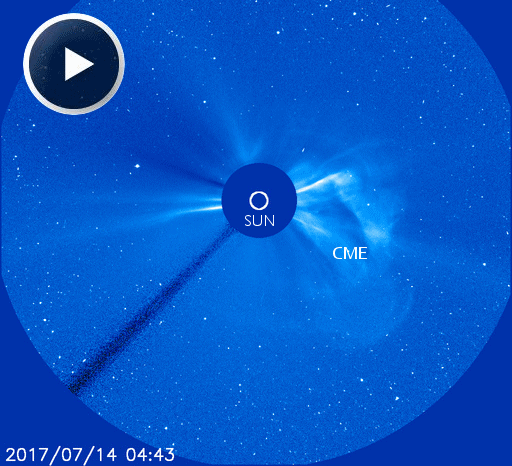
WHAT'S UP IN SPACE?
Space Weather
Lights Over lapland is excited to announce that Autumn Aurora Adventures are available for immediate booking! Reserve your adventure of a lifetime in Abisko National Park, Sweden today!
|
|
GEOMAGNETIC STORM WATCH: NOAA forecasters have analyzed this morning's solar flare and CME and they have issued a geomagnetic storm watch for July 16th and 17th. Storms could reach category G2 (moderately strong) on both days. High latitude sky watchers can expect midnight auroras on Sunday and Monday. Free: Aurora Alerts
STRONG SOLAR FLARE AND CME: After days of suspenseful quiet, huge sunspot AR2665 finally erupted on July 14th (0209 UT), producing a powerful and long-lasting M2-class solar flare. Extreme ultraviolet telescopes onboard NASA's Solar Dynamics Observatory recorded the blast:
Remarkably, the explosion persisted for more than two hours, producing a sustained fusillade of X-rays and energetic protons that ionized the upper layers of Earth's atmosphere. Shortwave radio blackouts were subsequently observed over the Pacific Ocean and especially around the Arctic Circle. This map from NOAA shows the affected geographic regions.
Of even greater interest is the coronal mass ejection (CME). The explosion hurled a bright CME away from the blast site, and it appears to be heading for Earth:
This expanding cloud will likely reach our planet on July 16th, possibly sparking geomagnetic storms and high-latitude auroras when it arrives. Stay tuned for improved predictions as NOAA analysts model the trajectory and potency of the incoming CME. Free: Aurora Alerts
Realtime Space Weather Photo Gallery
SOLAR ECLIPSE SPACE PENDANTS: Would you like to support our Solar Eclipse Balloon Network? Here's one way: Buy a space pendant. This solar eclipse-themed necklace flew to the stratosphere on July 2, 2017, attached to the payload of an Earth to Sky Calculus space weather balloon:
The payload contained more just like it. If you buy one now for $79.95, we will fly it back to the stratosphere during the Great American Solar Eclipse on August 21, 2017, where it will be enveloped by the Moon's cool shadow above our launch site in Oregon. No additional charge! Just make a note in the COMMENTS BOX of the shopping cart: "Please fly my pendant into the eclipse!" Each pendant comes with a greeting card showing the jewelry in flight and telling the story of its journey to the stratosphere and back again.
More items from the edge of space may be found in the Earth to Sky Store. All proceeds support atmospheric radiation monitoring and hands-on STEM education.
Far Out Gifts: Earth to Sky Store
All proceeds support hands-on STEM education
INCREDIBLE IMAGES OF THE GREAT RED SPOT: On July 10th, NASA's Juno spacecraft swooped over the Great Red Spot of Jupiter, only 9000 km above its swirling cloudtops. First-look images have just been released. Behold, the biggest storm in the Solar System photographed from point blank range:
Image credit : NASA / SwRI / MSSS / Gerald Eichstädt / Seán Doran © public domain
NASA is doing something new with its data from Juno. Instead of reserving images for selected researchers alone, the agency is posting raw images as soon as they reach Earth. Members of the public are invited to examine and process them. Keep an eye on the Juno Image Processing Gallery for the latest submissions.
Realtime Noctilucent Cloud Photo Gallery
|
|
| All Sky Fireball Network |
|
|
Every night, a network of NASA all-sky cameras scans the skies above the United States for meteoritic fireballs. Automated software maintained by NASA's Meteoroid Environment Office calculates their orbits, velocity, penetration depth in Earth's atmosphere and many other characteristics. Daily results are presented here on Spaceweather.com.
On Jul. 14, 2017, the network reported 45 fireballs.
(45 sporadics)
http://www.spaceweather.com/archive.php?view=1&day=14&month=07&year=2017





